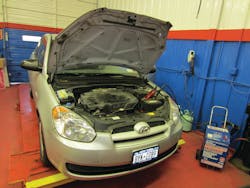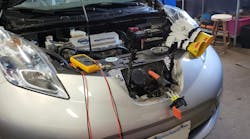Q: What should I look for when shopping for J2534 equipment?
A: First, you need the J-Box itself. They all cost around the same, so what you should be interested in is whether the piece of equipment is approved by the OEM. You can look this up at www.NASTF.org by looking at the "Reprogramming Information" section on the left side of the page. The National Automotive Service Task Force (NASTF) makes all this information on every OEM readily available in one place.
Second, you'll need a battery maintainer. You need a good low-AC ripple flow of high amperage during a reflash, and only a battery maintainer can provide this.
Third, you need a laptop with Windows 7. The reason is that in the real world you are going to need to be mobile when reflash, and the more wires you have hanging all over the place, the greater risk you take of killing a module. Furthermore, most J2534 applications are transitioning from Windows XP to Windows 7. Windows 7 has an XP emulator that allows you to use applications that only work in XP. This might help you during certain reflashes. However, an XP emulator is very slow, so if you can get the reflash software running in Windows 7 itself, it's best to stick with it. (See Fig. 1 and 2)
Q: Should I get into J2534 reprogramming? Is it profitable?
A: First, before you even worry about the money, do you have the staff? It is important to have computer savvy technicians for reprogramming, as it is quite technical. After all, you don't buy an alignment machine if you don't have anyone that can do an alignment.
Now, if you determine that you can train yourself or someone else to reflash here are some facts to consider in order to be profitable with J2534. Most reflashes take 30 to 45 minutes of your time, and the subscription from the OEM costs around $35 to $55. You need to charge enough for the service to cover your time and investment in tooling. So, how long would it take you to do 25 reflashes to pay for the equipment? Better yet, how much is it worth to you to keep the customer away from the dealer so you can get the brakes and maintenance work?
Reflashing should not be sold as a preventative service, but instead as a response to an OEM TSB. As little as three years ago, mostly European vehicles needed somewhat regular reflashes. Now, that's changing. Soon, you will not be able to regularly service vehicles without the ability to upgrade software. The question is not whether you will reflash, but rather how long will you hold out before you have to.
Q: Can I reflash all modules on all vehicles?
A: No, not really. Most manufacturers allow you to reflash PCMs and TCMs at most, so that you can solve an emissions issue. Now, reflashing a BCM has nothing to do with emissions, so they won't support it.
There are some notable exceptions. Toyota and GM are two examples of manufacturers with a 2-day, $55 subscription that allows you to reflash anything you want with the J-Box. (See Fig. 3) Volvo and BMW are the same, but they are very hard to get working properly and cost (Volvo is $225 for such a short-term subscription) is high.
To find out whether the car lines you work on offer the J2534 reflashing capability you want, go to www.NASTF.org and look at the "Reprogramming Information," just as we spoke about before.
Q: I have heard a lot of horror stories about frying PCMs; how do I avoid doing that?
A: Nissan recommends turning off your cell phone and putting a large piece of paper on the car that says, "This vehicle is being reprogrammed, stay away!"
Now, you might not actually need to do this, but in the real world there are a few precautions you do really need to take. In no particular order, here are a few. You should not be working with any tangled wires. Keep everything neat, because anything that might interrupt a reflash, like a lack of communication to a piece of hardware, can cost you the module, and you know you don't want to have to pay for that. Always double check that your DLC, USB ports and power cables are fully connected and not jiggling. (See Fig. 4)
Another precaution you should take is making sure your battery maintainer is hooked up properly to the vehicle's battery or to the jump-starting posts. Make sure you plug it in where no one else in the shop might walk by and kick out the wire by mistake.
Also, make sure that your laptop has its Windows, flash and Adobe updates all completed before you reflash. If any of these complete in the middle of a reflash and reset your computer, this can cause problems with on-board modules.
Lastly, make sure that anti-virus software is disabled. If the program automatically opens up when you are in the middle of reflashing, obviously that's not good. It's best to have a laptop that you use exclusively for automotive use, so that you don't need to worry about virus protection or programs that can cause conflicts with one another. (See Fig. 5)
Q: Where do I learn more about J2534 reprogramming?
A: There's no shame in knowing that there's always more to learn. Oftentimes it's best to learn it by real-world experience, being taught by someone who knows how to actually do it on a real car. However, if no one is willing to make you their J2534 disciple, do not fear!
You can get some training from instructors at training events, whether they be regional associations (i.e., Technicians Service Training in the Northeast) or national events (i.e., VISION). There might even be a hands-on trainer in your area. Training DVDs from a few providers (such as Technicians Service Training and AVI) also cover the topic.
A few free resources exist online. DrewTech's website (www.DrewTech.com) and the "OTC Tool Guy" Youtube Channel are very good and cover car-line specific reflashing. (See Fig. 6) OTC Tool Guy's videos, for example, in about six minutes cover exactly how you register on an OEM website and subsequently carry on your reflash. They have a lot of real-world tips, which are essential. In their video on reflashing Nissans, they warn you that after a successful reflash the software uses the word "failure," and cautions the technician not to be afraid. That tip comes in handy when you reflash your first Nissan so you don't freak out and think you fried the module!
Q: What is the most difficult thing about reprogramming?
A: Reprogramming can be tedious. You need to be very detail-oriented and follow every instruction given. Now, if all you had to do was one manufacturer, this would be simple enough. The problem is, every manufacturer is different and most of us work on several car lines. The best thing you can do is take your time when you reflash a manufacturer that you never have done before, and make use of online resources that give you step-by-step instructions.


